Get to Know Appalachia’s Vulnerable Species

The Appalachian region is home to numerous threatened and endangered species. Top: Roanoke logperch (Photo: Conservation Fisheries, Inc.), Indiana bat (Photo: USFWS). Bottom: Bog turtle, Small-whorled pogonia (Photos: USFWS)
In 1973, Congress passed the Endangered Species Act with the purpose of protecting and creating a recovery plan for native plants and animals in danger of becoming extinct. Although extinction is a natural process, human-induced environmental changes like deforestation and air and water pollution have quickened the pace of extinctions.
According to a 2014 study published in Science, humans have increased the extinction rate for plant and animal species by 1,000-fold. Stuart Pimm, the lead author of the study, told the Associated Press that this rate was about 10 times greater than biologists had previously believed.The researchers cite habitat loss as the most significant factor, though invasive species and climate change have also had a role in the increased extinction rate.
Major gas infrastructure projects like the half-completed Mountain Valley Pipeline in West Virginia and Virginia can also pose a threat to vulnerable species. Federal regulators halted Mountain Valley Pipeline construction in October 2019, shortly after the 4th Circuit Court of Appeals revoked a federal authorization that would have allowed developers to harm protected habitat. But on Sept. 4, the U.S. Fish and Wildlife Service reissued the authorization, called a biological opinion, holding to their previous claim that the pipeline would not harm the five threatened and endangered species in its path.
In Appalachia, the diversity of plant and animal life is vital for healthy forests, waterways and communities. It is important to save these species as they play a role in an intricate ecosystem, with each plant and animal contributing its part.
Meet eight of Appalachia’s endangered and threatened creatures below.
- Bog Turtle
- Carolina Northern Flying Squirrel
- Indiana Bat
- Small-whorled Pogonia
- Spruce-fir Moss Spider
- Roanoke Logperch
- Rock Gnome Lichen
- Appalachian Cottontail
Bog Turtle (Glyptemys muhlenbergii)
- Federal Status: Threatened, listed in 1997
- State Status: Endangered in Georgia; Threatened in North Carolina; Endangered in Pennsylvania
- International Status: Critically Endangered, 2010
- Fun Fact: These turtles hibernate in muddy areas anywhere from 6 to 18 inches deep in winter months.
Ranging from 3 to 4 inches in length, the smallest turtle in North America calls the Appalachian Mountains home. The bog turtle can be identified by its reddish-brown shell and patches of bright yellow on both sides of the neck region.
There are two distinct populations of bog turtle, one centering in the Northeast and the other in and near the Blue Ridge Mountains of the Southeast. The northern population is found in New York, Pennsylvania, Massachusetts and Maryland. In the southeastern region, bog turtles are most commonly found in North Carolina, but their range extends to Virginia, Tennessee, South Carolina and Georgia. Throughout this geographic range, bog turtles have been found across many elevations, ranging from near sea level to 4,500 feet.
In Georgia, North Carolina, South Carolina, Tennessee, and Virginia, the bog turtle is listed as threatened because it looks similar to another threatened species. When a species population is listed due to “similarity of appearance,” it means that law enforcement would not be able to differentiate between this and the actual threatened population, so it is illegal to kill the species regardless of where it lives. But not all of the Endangered Species Act protections apply to the “similarity of appearance” population.
Like their name suggests, bog turtles live in the mud and grasses of bogs, swamps and marsh areas. The turtles need a wet and muddy habitat and are sensitive to the effects of climate change. Changing hydrological cycles and a rise in erratic weather patterns can dry out or flood the wetlands in which bog turtles live. Invasive species like the purple loosestrife plant, found in areas of the northeastern Appalachian Mountain range, can dry out or overtake large areas of suitable habitat, restricting the movement of turtles. Bog turtles are also losing their habitat due to the draining and altering of wetlands for development or farming.
How Can You Help?
You can assist in bog turtle conservation efforts by supporting local and national wetland protection efforts and reporting illegal turtle trade.
Sources: Endangered Species Coalition, Savannah River Ecology Laboratory of the University of Georgia, U.S. Fish and Wildlife Service, North Carolina Wildlife Resources Commission, Chattahoochee Nature Center, Georgia Dept. of Natural Resources, Pennsylvania Game Commission, IUCN Red List.
Carolina Northern Flying Squirrel (Glaucomys sabrinus coloratus)
- Federal Status: Endangered, listed in 1985
- State Status: Endangered in North Carolina; Endangered in Virginia
- International Status: Not listed
- Fun Fact: The Carolina northern flying squirrel can not actually fly. Instead, their patagium, a piece of skin connecting the wrists and ankles, allows the squirrels to glide when stretching out their limbs.
In the last Ice Age, ice sheets covered North America, driving many creatures south. As temperatures warmed and the ice sheets receded, many plants and animals remained in the mountain peaks of Southern Appalachia. The isolated mountain populations became increasingly distinct over time. This is the case of the Carolina northern flying squirrel.
The Carolina northern flying squirrel, found only in the southern Appalachian Mountains, is a subspecies of the northern flying squirrel. They are typically found in cool and moist areas of high elevation, like mixed red spruce-northern hardwood and spruce-fir forests. The species can be found in Southwest Virginia, Western North Carolina and East Tennessee.
Northern flying squirrels have brown fur on their backs and gray and white fur on their underbellies. Though this species is difficult to distinguish from the southern flying squirrel, the southern variety tends to be smaller and live in dry, warm forests at lower elevations.
The limited range of this subspecies in southern Appalachia leaves it vulnerable to threats from humans and the natural world. Deforestation due to recreational and residential development and invasive species can affect squirrel populations. The balsam woolly adelgid, an invasive European insect introduced by humans, infects and kills fir trees, damaging the forests that these squirrels inhabit.
How Can You Help?
Avoid damaging vegetation that this species feeds on by treading lightly in wild areas and remaining on designated trails.
Sources: U.S. Fish and Wildlife Service, North Carolina Wildlife Resources Commission, Virginia Dept. of Wildlife Resources.
- Federal Status: Endangered, listed in 1967
- State Status: Endangered in Georgia; Endangered in Kentucky; Endangered in Ohio; Endangered in Pennsylvania; Endangered in Virginia
- International Status: Near Threatened as of 2016
- Fun Fact: The Indiana bat weights about the same as three pennies.
With a Latin name that translates to “mouse ear companion,” the Indiana bat sports mouse-like ears and a wingspan of 9 to 11 inches. With dark brown or black fur, this social bat species can be difficult to distinguish from its winged cousins.
The Indiana bat was first distinguished as a species in 1928 based on a specimen found in Indiana’s Wyandotte Cave in 1904.
This bat can be found in the Midwest, but also in the Appalachian regions of Maryland, North Carolina, Pennsylvania, Virginia and West Virginia. During the winter months, Indiana bats hibernate in caves or abandoned mines, requiring cool, humid areas with a stable temperature range of 32° F to 50° F. In the summer, these bats migrate to woodlands near small rivers and streams. Roosting under loose tree bark on dead or dying trees, males tend to roost alone or in small groups while females can be found in groups of 100 or more.
Since very few caves or mines have the conditions Indiana bats require, they are vulnerable to disturbance. If the bats are disturbed or cave temperatures rise, the hibernating bats may starve as stored fat is their only source of energy during winter. Additionally, the loss of suitable summer habitats, commercialization of caves and white-nose syndrome have all contributed to population decline.
White-nose syndrome is caused by a fungus that attacks the skin of hibernating bats. As the fungus grows and thrives in the cold, dark and damp habitat of the caves where these bats are found, it causes the bats to become more active. This activity burns the fat required for survival in the winter.
In 2019, Appalachian Voices, the nonprofit organization that publishes The Appalachian Voice, was one of seven groups that filed a lawsuit against the unfinished Mountain Valley Pipeline for its impact on endangered species, including the Indiana bat. The lawsuit centers around the U.S. Fish and Wildlife Service’s 2019 approval of the pipeline that, environmental groups argue, failed to measure impacts on endangered species and did not set limits on the number of bats that could be harmed during construction. Since October 2019, construction other than land stabilization activity has been stalled along the pipeline’s entire route.
How Can You Help?
You can help the Indiana bat and its habitat by advocating for the closure of caves inhabited by the species to human activities and supporting campaigns to fight white-nose syndrome. Read about actions you can take in your backyard to help bats.
Sources: U.S. Fish & Wildlife Service, National Wildlife Federation, Georgia Dept. of Natural Resources, Kentucky Dept. of Fish & Wildlife Resources, Ohio Dept. of Natural Resources, Pennsylvania Game Commission, Virginia Dept. of Wildlife Resources, IUCN Red List.
Small-Whorled Pogonia (Isotria medeoloides)
- Federal Status: Threatened, updated from Endangered in 1994.
- State Statuses: Endangered (CT, MA, ME, MO, NC, NJ, NY, OH, TN, VT); Threatened (GA, NH); Extirpated (MI)
- International Status: Vulnerable as of 2014
- Fun Fact: The flowers of the small-whorled pogonia lack both nectar and scent.
Although found across the eastern United States, most populations of the small-whorled pogonia have less than 20 plants. This flower is a member of the orchid family with a grayish-green stem and height ranging from 3 to 13 inches. A whorl, or pattern of spirals, of five or six leaves sits at the top of the stem. One or two flowers, usually yellowish-green in color, sit at the center of the whorl.
The small-whorled pogonia is found in acidic, moist, nutrient-deficient soils in areas with moderate ground cover. Too many plants in an area can overcrowd and harm the plant. The orchid typically grows in open areas or mixed-deciduous forests that provide breaks in the forest canopy.
Commercial and residential development has led to habitat loss and has eliminated productive habitats where small-whorled pogonia populations once thrived. The plant also suffers from poor seed establishment as seeds must fall on a certain type of fungus to germinate. This results in new plants not replacing older ones as they die, leaving populations small and vulnerable. This species is also in the path of the Mountain Valley Pipeline, and developers of the proposed 73-mile Mountain Valley Pipeline Southgate extension into North Carolina have noted its potential presence in the pipeline’s path.
How Can You Help?
To help conserve this orchid’s habitat, stay on established trails when hiking, avoid disrupting vegetation and advocate for the protection of rare species.
Sources: U.S. Fish and Wildlife Service, USFWS Asheville Ecological Services Field Office, USFWS New Jersey Field Office, North American Orchid Conservation Center, IUCN Red List.
Spruce-fir Moss Spider (Microhexura montivaga)
- Federal Status: Endangered, listed in 1995
- State Status: Endangered in Virginia
- International Status: Not listed
- Fun Fact: The spruce-fir moss spider is one of the smallest members of the suborder of spiders known as Mygalomorphae, or “tarantulas.”
The spruce-fir moss spider lives in Southern Appalachia, calling the mountains of North Carolina, Tennessee and Virginia home. The spider is about the size of a BB, with adults measuring from 0.10 to 0.15 inches. They have no abdomen markings and their coloring ranges from light brown to a dark reddish-brown.
Found in fir and spruce-fir forests at elevations above 5,400 feet, this spider thrives in damp areas. Living up to their name, the spider’s typical habitat is moss mats growing on well-shaded rocks and boulders.
Because they are so dependent on these moss mats, habitat destruction and damage to surrounding vegetation threaten the species and could result in the loss of entire populations. The balsam wooly adelgid damages and kills mature Fraser fir trees, resulting in the thinning of tree canopies in the spider’s habitat. This can result in increased sunlight in mossy areas, increasing temperature and decreasing moisture levels. When the moss mats lose moisture, the spider will likely dry out. Climate change and rising temperatures have a similar result. Destructive logging practices in the 20th century and air pollution also have had a negative effect on the spider’s environment.
How Can You Help?
Look for opportunities to become involved in stewardship of the high-elevation forests these spiders call home. Advocate for your local and federal governments to create policy that mitigates climate change.
Sources: U.S. Fish and Wildlife Service, USFWS Fact Sheet, Virginia Dept. of Wildlife Resources
Roanoke Logperch (Percina rex)
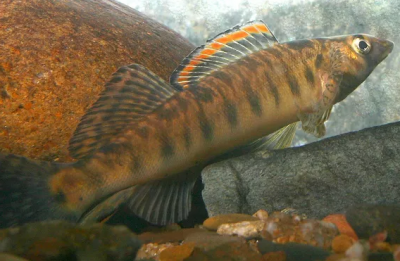
Photo courtesy of Conservation Fisheries, Inc.
- Federal Status: Endangered, listed in 1989
- State Status: Endangered in North Carolina; Endangered in Virginia
- International Status: Vulnerable as 2012, reclassified from Endangered in 1996
- Fun Fact: These fish hunt by using their snouts to flip over pebbles to find small invertebrates to eat.
The Roanoke logperch is a freshwater fish that can grow up to about six inches in length. Cylindrically shaped, the fish are easily recognized by the prominent dark bar markings that line their greenish-yellow sides.
This species is currently found in five river systems across North Carolina and Virginia, including the Roanoke, Pigg, Smith, Nottoway, Meherrin, and Dan river watersheds. Most populations are isolated and fragmented due to several dams within these waterways. The fish thrives in clear, unpolluted water and is found in warm streams and small rivers of a low to moderate gradient.
According to the Center for Biological Diversity, alterations of river systems in the Eastern United States have resulted in 20 darter and logperch species in addition to the Roanoke logperch being federally listed as endangered or threatened. All are members of the Percidae family. The logperch is threatened by pollutants stemming from urban construction, agriculture and highways. In 2014, the species was impacted by the Dan River coal ash spill, when over 39,000 tons of ash contaminated approximately 70 miles of the river. Sediment pollution is also an issue for the Roanoke logperch.
The construction of the Mountain Valley Pipeline has affected this species. In 2019, the pipeline developer’s weekly status reports showed an increase in sedimentation problems as a result of increased construction activity in Roanoke logperch habitat. Appalachian Voices was one of various environmental groups that called for a halt in construction until the sedimentation impacts on the species is adequately assessed. As a result of this lawsuit, construction of the pipeline has been stalled since October 2019.
How Can You Help?
If you own a property that borders a waterway within this species’ habitat, avoid using chemicals and fertilizers that can enter the water through runoff. Maintain a buffer of natural vegetation along the bank to help reduce any runoff. This will also help control erosion and siltation.
Sources: Center for Biological Diversity, Conservation Fisheries, Inc., U.S. Fish and Wildlife Service, USFWS Raleigh Ecological Services Field Office, North Carolina Wildlife Resources Commission, Virginia Dept. of Wildlife Resources.
Rock gnome lichen (Gymnoderma lineare)
- Federal Status: Endangered, listed in 1995
- State Status: Endangered in Georgia
- International Status: Vulnerable as of 2015
- Fun Fact: The rock gnome lichen is the only member of the genus Gymnodera to live in North America.
Found in the mountains of Georgia, North Carolina, South Carolina and Tennessee, the rock gnome lichen thrives in moist, open areas of high humidity. It is one of two lichens federally recognized as threatened or endangered species. The rock gnome lichen needs a fair amount of light, but also needs some canopy coverage to avoid high-intensity sunlight. This species is found in colonies in lobe-like shapes generally 1 millimeter wide and 1 to 2 centimeters long. On the upper surfaces, these lobes are a blue-gray color, but appear white on the lower surface. Both the base and the fruiting bodies are black.
Rock gnome lichen is found at locations that are often ideal for forms of outdoor recreation like hiking, climbing and sightseeing. Soil erosion and compaction from these activities can affect the species. Both the balsam wooly adelgid and hemlock wooly adelgid attack and kill trees found in rock gnome lichen habitat. When these trees die, the lichen is exposed to more sunlight. Air pollution and development are also harmful to the lichen.
The death of these trees can reduce the amount of shade coverage, harming the lichen with excess sunlight. Other threats include residential development and air pollution.
How Can You Help?
When hiking, avoiding climbing or walking on lichen-covered areas. Participate in the protection and restoration of forests harmed by the balsam and hemlock wooly adelgid.
Sources: U.S. Fish and Wildlife Service, USFWS Raleigh Ecological Services Field Office, Georgia Dept. of Natural Resources, IUCN Red List.
Appalachian Cottontail (Sylvilagus obscurus)
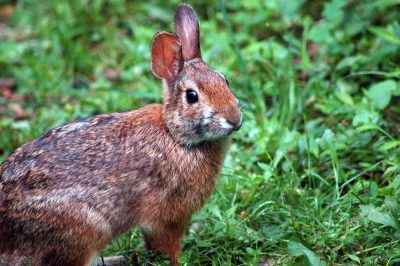
Photo by Ketzirah Lesser & Art Drauglis/CC BY-SA 2.0
- Federal Status: Not listed
- International Status: Near Threatened as of 2018
- State Status: Species of Greatest Conservation Need in Kentucky, Maryland, Pennsylvania, Virginia and West Virginia; Rare in Georgia; In Need of Conservation in Maryland; Regional Species of Greatest Conservation Need in Pennsylvania
- Fun Fact: These rabbits like to munch on blueberry and blackberry bushes just like we do!
Note: Even though the Appalachian cottontail is not federally listed under the Endangered Species Act, several states note that the species is at risk. Plus, this rare rabbit is too cute to leave off our list!
The Appalachian cottontail is a rare species of rabbit found throughout the Appalachian Mountains. With its brown upper body and white underside, it can be difficult to distinguish from the eastern cottontail. However, the Appalachian cottontail tends to be of smaller build and sports a black spot between its ears rather than a white spot on the forehead, which is common to eastern cottontails. The Appalachian cottontail was first described as a distinct species in 1992.
If you see a cottontail at an elevation of 2,500 feet or greater in the Appalachian region, it is likely an Appalachian cottontail — though eastern cottontails can infringe on this territory if the landscape allows. The International Union for the Conservation of Nature describes this species as ranging from the mountains of central Pennsylvania to northern Alabama, inhabiting brushy shrubland, woodlands and inland wetlands.
Habitat destruction from human development is contributing to a population decline for the Appalachian cottontail, as are the effects of tourism, urbanization and utility and service lines. As of 2015, Kentucky, Maryland, Pennsylvania, Virginia and West Virginia listed the rabbit as a Species of Greatest Conservation Need, according to The Young Forest Project.
How Can You Help?
In areas where Appalachian cottontails live, avoid trapping and hunting rabbits. You can also advocate for minimal urbanization of woodlands and other habitat.
Sources: North Carolina Wildlife Resources Commision, The Young Forest Project, Georgia Dept. of Natural Resources, Maryland Dept. of Natural Resources, Pennsylvania Game Commission.
Related Articles
Latest News
More Stories

Leave a comment
Your email address will not be published. Required fields are marked *
2 responses to “Get to Know Appalachia’s Vulnerable Species”
-
The northern bog turtle population is almost ENTIRELY in New Jersey. New Jersey is apart of appalachia and I’m tired of every article and website discrediting Jersey’s mountains. Bog turtles are almost endemic to New Jersey, the southern population is much smaller in comparison. Give us credit where it’s due.
-
I am a student in 6th grade that lives in Appalachia, and I thank you for making this website. This is very educational.


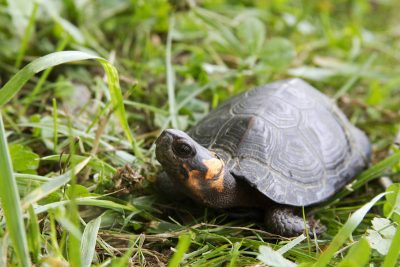
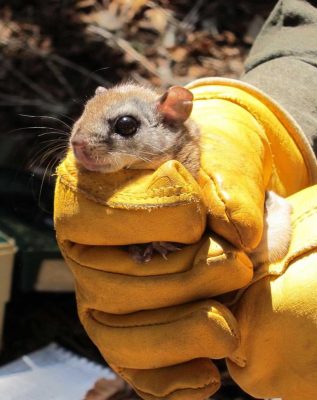

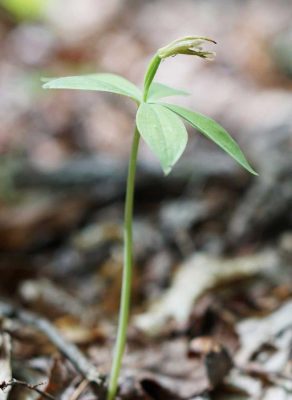





Leave a Comment